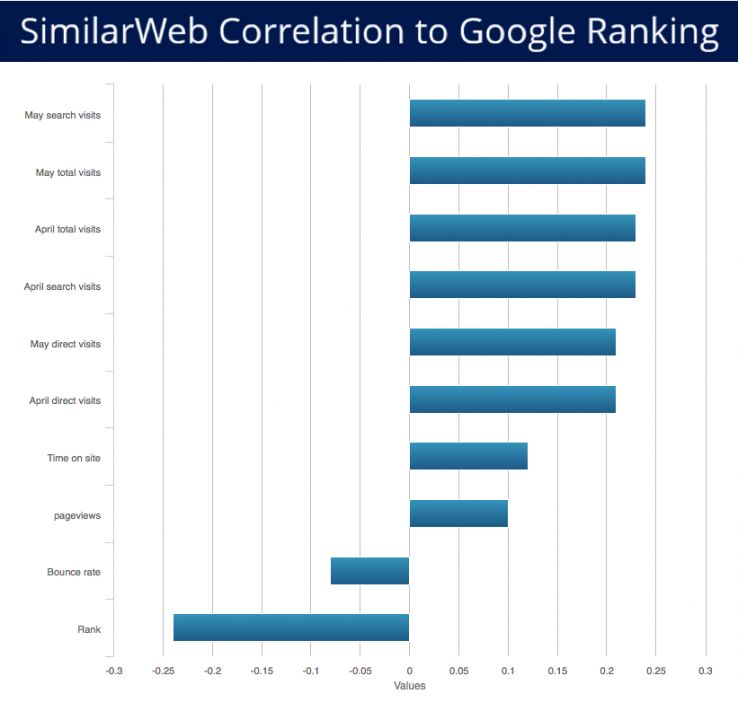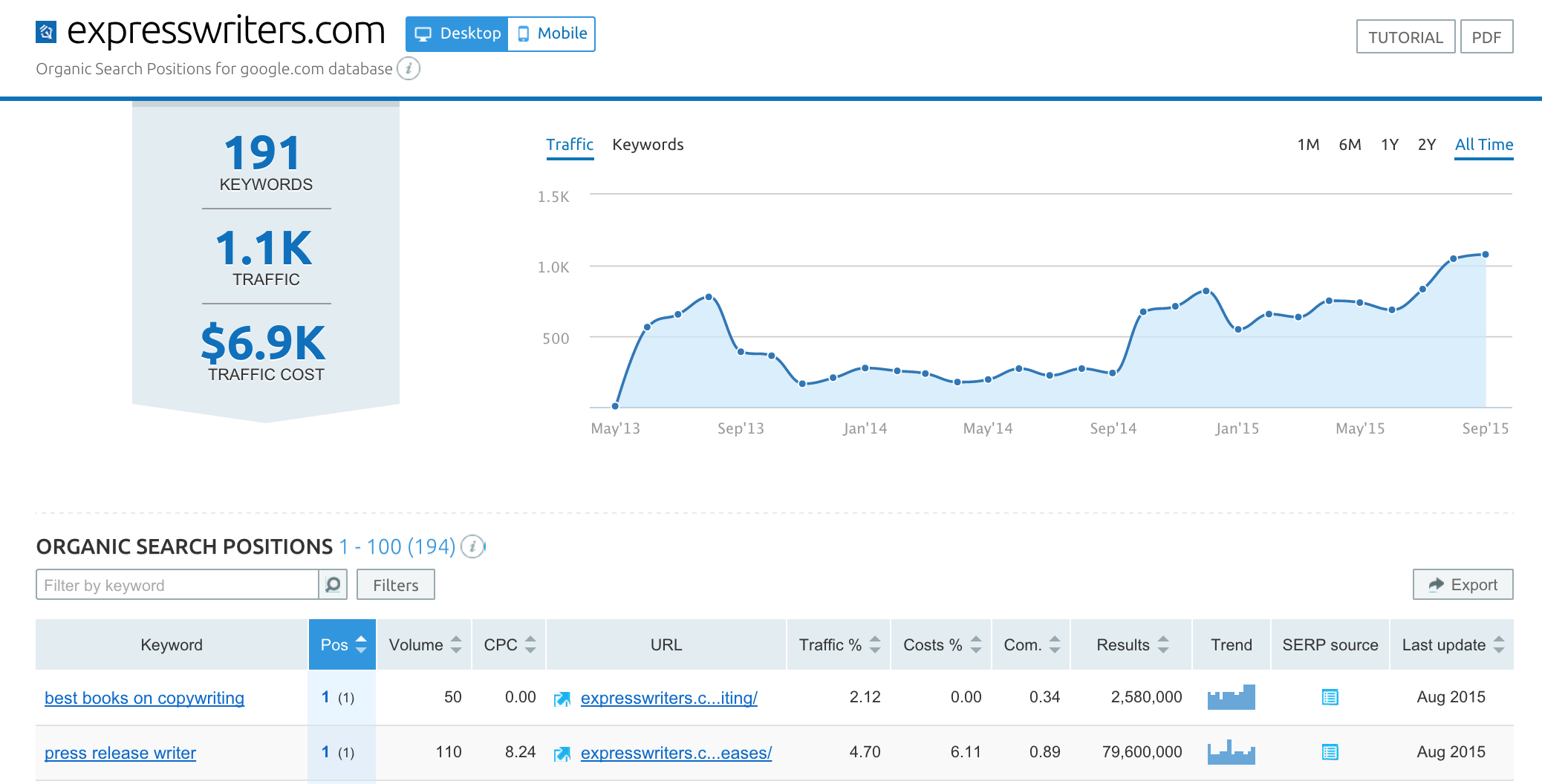The Internet is evolving — and marketing as a whole has evolved with it.
As time goes by, many things we all once knew as solid and concrete have become footnotes in history. This is particularly true of the Internet and search. Every Internet marketer remembers when keyword density and the technical side of SEO were of the utmost importance to getting traffic. Keywords were the first stab Google made at giving users relevant results.
Then, by utilizing a series of interconnected metrics, Google was able to provide valid, on-topic (more or less) search results, something unheard of until they made it a reality.
The last couple of years has seen Google really amp up its gears regarding the quality and control of its search results. The developments are both interesting and jolting.
I’m going to show you how there’s been a major (I mean major) shift from PR (PageRank) to topical trust flow.
Ready? Let’s dig in.
How Does the PageRank Metric Work?
How relevant is your website to a search? Well, Google’s first attempt at answering the question in order to give users the results they wanted from an Internet search produced the PageRank metric.
Bruce Clay Inc. outlines PageRank as an algorithm that takes into account over two hundred pieces of information, including incoming and outgoing link data, in order to determine the relative value of the site to a user.
The relevancy of these links also factor into the equation and the final PageRank score determines exactly how valuable the page is.
Google’s search results are served to the user based on the keywords they entered and the highest PageRank score sites for those pages.
From this, you can see how important PageRank is for good traffic. Internet marketers have been using search engines to drive traffic for as long as search engines existed. PageRank made us change our tactics a bit, and those who were unable to keep up with the changing technology or didn’t grasp it fully enough folded and crashed into ignominy. And way back when, links were among the #1 way to boost a site’s PR. Remember back in 2009 when Angie & Paul’s backlinks were all the rage?
Today, something new (and better) is on the horizon, and it’s likely to change the way we view search results forever.
Change is in the Air: A Values-Based Search System
Starting with Google’s Penguin and Panda updates and slowly incorporating all its other updates, the search engine giant started to filter the chaff from the wheat of the Internet. Sites that used to get traffic through heavily stuffed keywords were now useless to their owners. Sites that depended upon traffic by utilizing bad linking and links from dangerous and dodgy sites were penalized. The Internet became a safer place for the user. This was only one step in Google’s big forward leap in search engine technology.
With successive updates, it introduced the PageRank system and taught us how to use it and how important it was for traffic to our sites. We followed along diligently, adapting our SEO to match Google’s demanding structure. But what we have come to realize the more we see Google update is that the search engine is no longer simply looking at PageRank to determine how valid your site is. Google is now looking to give users relevant results that fit their needs perfectly. To do this, it needs to change the way it indexes and searched pages online. The paradigm shift is happening subtly, but inexorably.
Unexpected Moz Findings: Engagement Metrics and Page Ranking
The results from this year’s Ranking Correlation Study by Moz gave us some surprising insight into this new system of search ranking:


Usually, when the ranking correlation study is undertaken it uses metrics we already have a handle on in order to determine how those metrics affect the ranking of a page and if one or more of them have become more important since the last study.
This year, however, Moz included some data sets they had never before used provided by SimilarWeb. The results were not what anyone expected.
How the new data metrics varied from what we used before was that these new metrics were more user-based than analytical metrics. They focused on the users themselves and gave feedback based on what the users did. This gave us a clue towards what Google was planning as regards their newest change to the idea of search metrics. The data showed us that there was a definitive link between PageRank score and traffic, which we already suspected. The question was if the PageRank drove the traffic or if it was the other way around.
When we looked at the engagement metrics from the user-based set, we got a little insight into how they could lead to more traffic and by extension cause the PageRank to rise.
Metrics such as:
- bounce rate
- time on site
- page views
…all depend upon users visiting this site. This counts as inbound traffic.
When we take into account the traffic to the site and compare it to how these user-based metrics compared to PageRank, it was found that they each had their own little pull on the PageRank score.
Together, they could cause quite a bit of difference, helping us to draw the conclusion that Google is up to something regarding user-based metrics to give better search results.
Google Welcomes (And Focuses On) a User-Based Internet
It’s been a subject of speculation for quite some time that Google is slowly changing the internet into a more user-friendly place. No longer do you have to worry that a site will contain something malicious or illegal. More than that, Google’s results are now even more valid than ever. You usually find exactly what you’re looking for by the time you get to the second or third result.
What Google is doing is taking the users’ data into account in order to give better search result data to users in the future.
By leveraging these metrics, Google has pretty much taught its search engine how to use the opinions of previous users to give better search results without tapping into the user’s personal and private information.
All the data that Google uses is right there and openly available. It’s a stroke of genius to put it all together to come up with a way to figure out how relevant a page is to search terms.
If Google can do it, so can we.
Introducing Topical Trust Flow
In April 2013, Majestic SEO announced they had categorized the entire web. It sounded ridiculous. They couldn’t be serious. But they were, and as history would have it, they were miles ahead of their time. Majestic’s system was called Topical Trust Flow, and it looked like it wouldn’t be very useful. As time went by, however, it turned out that Majestic was relatively spot-on with their prediction of the success of a page in a particular category. This obviously called for more investigation.
 Topical Trust Flow splits up the site’s relevance in a number of categories that it is most likely to perform well based on the content of the site and the inbound and outbound link data. Majestic announced is has nearly one thousand categories, divided up into broad spectrum areas such as News of Politics and further subdividing those into more manageable classifications.
Topical Trust Flow splits up the site’s relevance in a number of categories that it is most likely to perform well based on the content of the site and the inbound and outbound link data. Majestic announced is has nearly one thousand categories, divided up into broad spectrum areas such as News of Politics and further subdividing those into more manageable classifications.
This allows you to classify a website based on its relevance in a particular field as well as other fields that may or may not be related to it. It turns out that this is exactly what Google was thinking.
Why Topical Trust Flow Matters
Remember Moz’s research I mentioned earlier? What it uncovered can be easily explained if we consider Google may now be phasing out PageRank in favor of a more topically-based search system. It would be in line with their ongoing campaign to make the Internet more user-friendly and to deliver more relevant search results to its users.
Topical Trust Flow is the new “it” factor for websites.
Basically, it allows you to see, at a glance, whether a site is relevant in the industry it’s in. Since Google is now considering the topic of a site when it indexes it, the more we know about what areas the site is linked to, the better off we are in determining how well it will show up on searches.
Topical Trust Flow can give you insight into where the links to and from the site are based and from that allow you to see how relevant the site is in the grander scheme of things.
A site that is based in technology but has more links to sports sites than other technology sites might demonstrate a very high link value, but actually perform poorly in topical searches.
This is an added factor to consider in the future of SEO development and strategizing.
The Question of Good Content
Since we’ve been on the topic of Google’s change in paradigm, we’ve almost completely neglected the reason why Google decided to do this. I mean, isn’t a well-linked page a good enough testament to how well-regarded the site is by its peers?
The answer is not necessarily, and that’s why Google decided they needed to up the ante. Their recent updates have been focused on building a value-based internet, and although delivering relevant search results is the first step in this solution, the second requires the content they give to their users be beneficial to them.
Good content, as we have been told many times over, is content that benefits the user in some way, either by imparting new information to them, by giving them a new perspective on an old issue, or by discussing a brand new issue. Google has decided that new, fresh content that is relevant to a site’s usage is the most important thing that a site can contribute to its own success in search rankings.
As we have seen before, user-based metrics impact the traffic that comes from search engine results quite a bit. The way to address these user-based metrics is by developing good content.
How Does DA Fit In?
This is a question that will naturally come up with anyone reading this who knows about the MozBar DA metric. How does DA fit in? First, let’s explain it.
Basically, the MozBar DA (Domain Authority) tells you a rating for any website you’re on. I have it as an extension on my Google Chrome browser, and the button is showing me an 85 rating right now for Search Engine Journal (which is a rockin’ rating, by the way!):
![]() DA is a 100-point scale rating developed by Moz that predicts the viability of a website in terms of ranking. This is your website “strength”. Domain Authority on a 100-point, logarithmic scale. Thus, it’s easier to grow your score from 20 to 30 than it would be to grow from 70 to 80. The DA is so widely used that in most marketing circles I’m in, most of the time people are talking about DA instead of PR. All other link metrics that were developed by Moz go into this algorithm calculation, including MozRank, MozTrust, linking root domains, number of total links, etc. Over 40 signals go into the calculation, which means fluctuations happen often.
DA is a 100-point scale rating developed by Moz that predicts the viability of a website in terms of ranking. This is your website “strength”. Domain Authority on a 100-point, logarithmic scale. Thus, it’s easier to grow your score from 20 to 30 than it would be to grow from 70 to 80. The DA is so widely used that in most marketing circles I’m in, most of the time people are talking about DA instead of PR. All other link metrics that were developed by Moz go into this algorithm calculation, including MozRank, MozTrust, linking root domains, number of total links, etc. Over 40 signals go into the calculation, which means fluctuations happen often.
DA Vs Page Authority
Whereas Domain Authority measures the predictive ranking strength of entire domains or subdomains, Page Authority measures the strength of individual page. The same is true for metrics such as MozRank and MozTrust.
The Problem with DA: It Scales with Spam
Just this year more than 24 billion Chinese spam sites were included by accident in Moz’s index, inflating DA for everyone. See Rand Fishkin’s tweet on that. This spam scaling problem hasn’t been fixed yet, to my knowledge.
This is the biggest reason the DA metric is flawed, although it’s being perfected by a dynamic team that has their fingertips on a lot of great metrics. I think in the future the DA metric will be more set in stone.
Don’t use DA to guide your strategy; that’s my final advice on the DA ratings.
Express Writers: A Personal Case Study
My company, Express Writers, has utilized organic search quite effectively to drive traffic to our site. I write about four to five blogs (at least 1,500 words on average) and post to our blog weekly, along with bi-weekly auditing our existing content.
My overall SEO strategy is content. Guest blogging on a massive extent: Twitter chats, hiring a full-time social media specialist, adding multiple blog contributors, creating infographics and videos, and we are going to start creating books (Kindle and free e-books).
Through our large content production schedule and cycle, we have managed to set ourselves up as one of the most relevant online writing agencies in business today. We outrank as much as 95% of our competitors in this heavily contested industry, proving how well our strategy works to promote our business.
Here’s a recent screenshot from SEMrush, our favorite SEO analytics provider, on our ranking stats:

By the way, we aren’t paying a penny of the estimated traffic cost…that $6.9k cost would be what it might cost if we did PPC (which we have no plans of doing).
On average we get between 500 – 700 users daily in organic traffic just from Google keywords. In a business like ours, exposure is one of the most important cornerstones of a company. Out of 165 indexed keywords, we rank in the top ten for 100 of them.
Looking at the growth of our business over the last few years it’s obvious how organic search has helped us reach this pinnacle and will take us well beyond.
Quality Content Wins
The major driving force in our marketing strategy is the use of good, high quality, worthwhile content. If you’re reading this, and you feel I’ve answered maybe one content marketing question you had before you read this post – then I’ve achieved my goal in producing useful content.
And I work hard to keep this standard. If I deliver substandard content through a guest blog or through our long-form company content blogs, I stand to lose a lot more than just my reputation.
Good content affects user experience, which in turn affects your user-based metrics, finally impacting on your overall page visibility in Google’s results for a particular topic.
It’s a long trail to follow, but once you figure it out, it’s just a matter of utilizing it to improve your own site’s presence.
The Rest of the Story: Good Content is Where It’s at Today
Creating content of the highest quality is probably the most important part of any SEO strategy. Now you understand why.
As time goes by, I predict Google will depend less and less on PageRank and instead focus on more topical-based search metrics such as Topical Trust Flow. It’s only been a trend the last 24 months or so.
Knowing what you’re in store for allows you to be prepared for when the future hits. I firmly believe the only way to not suffer when ranking changes happens is by maintaining the standard of your content.
(True, I’ve published a few posts I wasn’t proud of in the past, but everything I publish today I am proud to put my name to.)
Good content is one of those things that will never cease to be relevant: and with millions of pages searched daily, businesses today have the chance of a lifetime to work hard, create some awesome stuff, and be a part of this growing content phenomenon. Don’t be left out.
Image Credits
Featured Image: alphaspirit/Shutterstock.com
In-post Photo #1: Rawpixel/Shutterstock.com
Majestic Topical Trust Flow chart, used with permission
Moz Chart from SimilarWeb & Moz, used with permission





